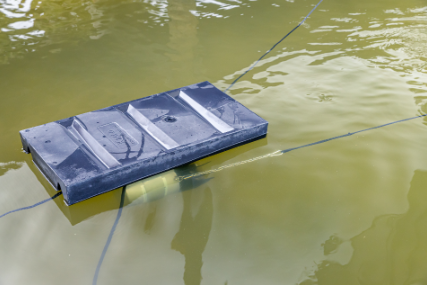If aeration is one of the top forms of overall pond management and the best way to balance a pond ecosystem, circulation is a close second. Circulation, just like the blood in your veins, is critical to a healthy, vibrant pond ecosystem. Without circulation, natural biological processes become imbalanced and do not function properly.

Most aeration devices also involve a varying degree of circulation and water movement. Not only do you get improved dissolved oxygen and all its benefits, but you also eliminate common stagnant water issues such as stratification, turnover, floating plants and debris, and mosquitoes.
Stratification
The layering of water by temperature and density can cause major problems within a pond. For example, it can limit fish habitat, slow down decomposition processes and lead to dangerous chemical properties in the pond. Using an aeration or circulation device can prevent, and in some cases eliminate, this stratification completely.

As with many things in life, it is easier to prevent a stratification problem before it starts. Therefore, it is recommended to install an aeration or circulation system in the spring before the layering has occurred. If it has already developed, you can still address it, but you need to take caution to not inadvertently mix too quickly which could lead to a turnover.
Pond Turnover
Pond Turnover is the process of a layered or stratified pond mixing when density barriers are lost. This can be catastrophic for fish if oxygen levels drop too low. Adding an aeration or circulation device can help mitigate this risk by providing oxygen while removing the stratification of the pond.

Floating Plants and Debris
Circulation can also help limit floating plants like Duckweed and debris that end up near your shoreline. Floating debris can be better managed by pushing it into areas where it can be easily removed. This is especially important for urban areas where rubbish can find its way in or around docks, marinas, or boats. In cases such as marinas and bays, strategically placed circulators can prevent floating debris from entering the area altogether.

In addition to clearing debris, moving water also deters some floating plant species from growing. Most floating species of plants prefer stagnant water. By creating water movement, you can limit or even prevent growth. The faster the water is moving at the surface, the less likelihood there is of having major algae, duckweed, or other floating plant problems.
Mosquitoes

Mosquitoes can be a major problem. Part of the mosquito life cycle depends on stagnant water areas where the mosquito larvae can “hang” onto the surface tension of the water. By introducing circulation and movement to the water, you can disrupt the surface tension. Doing so causes the mosquito larvae to sink and drown. Since mosquitos can reproduce in tiny puddles and very small amounts of water, simply circulating the water in your pond may not be enough to get rid of all your mosquitoes. However, you can at least reduce their numbers by making sure your pond water is always moving.
Contact us to learn more about how our products can help prevent stagnant water and make your pond or lake healthy and desirable again.
